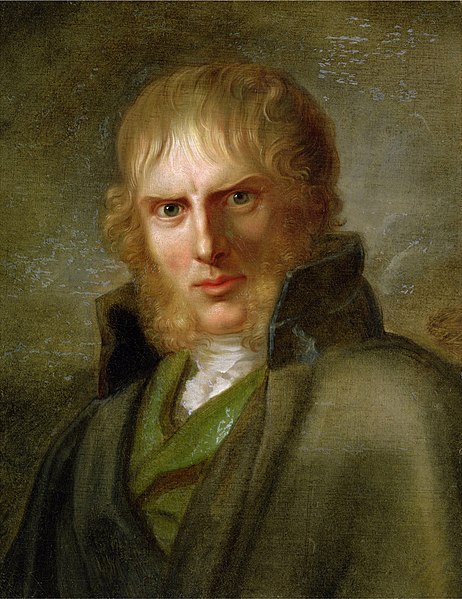
Born: 5 September 1774, Greifswald
Died: 7 May 1840 (aged 65)
Period: Romanticism
The Life of Caspar David Friedrich
Caspar David Friedrich (1774–1840) was a 19th-century German painter and a leading figure in the Romantic movement, known for his evocative landscapes that explore themes of nature, emotion, and spirituality. Born in Greifswald, then part of Swedish Pomerania, Friedrich’s early life was marked by tragedy and loss, including the death of his mother when he was just seven, and later the loss of a brother, which profoundly influenced his introspective and often melancholic perspective.
Friedrich studied at the Academy of Copenhagen, where he was initially trained in the neoclassical tradition. However, he soon developed a distinct style that focused on the sublime beauty of nature, often incorporating symbolic elements that reflected his deep religious faith and philosophical interest in the transcendence of the natural world. His landscapes are characterized by their meticulous detail, dramatic use of light, and the sense of solitude and introspection they evoke.
One of Friedrich’s most significant contributions to art was his ability to infuse landscapes with symbolism and emotion, making them not just representations of nature, but expressions of the human condition and reflections on life, death, and faith. His paintings often feature figures seen from behind, gazing into vast expanses, misty mountains, or the sea, inviting viewers to contemplate their own relationship with nature and the divine.
Friedrich’s work was not fully appreciated during his lifetime, and his later years were marked by illness, depression, and financial difficulties. However, his reputation grew posthumously, and he is now celebrated as a master of Romanticism and one of the most important German artists of his era. His influence is evident in the works of later artists, including the Symbolists and Surrealists, and his paintings continue to be revered for their profound emotional depth and sublime beauty.
Notable works by Friedrich include “Wanderer above the Sea of Fog” (c. 1818), “The Monk by the Sea” (c. 1808-1810), and “Abbey in the Oakwood” (c. 1809-1810), which exemplify his thematic focus on the sublime and the contemplative, solitary figure within the vastness of nature. These masterpieces, among others, underscore Friedrich’s enduring legacy as an artist who deeply understood and depicted the complex interplay between humanity and the natural world.
Caspar David Friedrich’s Notable Works
Caspar David Friedrich is renowned for his poignant and contemplative landscapes that explore the spiritual and emotional resonance of nature. His works are key to understanding the Romantic movement’s emphasis on the sublime and the individual’s relationship with the natural world. Here are ten of Friedrich’s most famous and influential works:
- Wanderer above the Sea of Fog (c. 1818) – This iconic painting depicts a lone man standing atop a mountain, looking out over a sea of fog. It’s often seen as a symbol of the Romantic era, representing the exploration of the self and the sublime mystery of nature.
- The Monk by the Sea (c. 1808-1810) – A minimalist landscape that portrays a solitary monk beside the sea under a vast, empty sky. The painting is noted for its evocation of loneliness and the sublime infinity of nature.
- Abbey in the Oakwood (c. 1809-1810) – A companion piece to “The Monk by the Sea,” this work shows a procession entering the ruins of a Gothic abbey in a winter landscape. It’s a meditation on themes of death, decay, and the passage of time.
- The Sea of Ice (c. 1823-1824) – Also known as “The Wreck of Hope,” this painting depicts a ship crushed by ice floes. The work is a powerful expression of nature’s overwhelming force and the human vulnerability.
- Chalk Cliffs on Rügen (c. 1818) – Painted after his honeymoon, this landscape features Friedrich, his wife, and his brother on the chalk cliffs of Rügen Island. The painting is celebrated for its detailed rendering of nature and the feeling of sublime transcendence it evokes.
- Morning in the Riesengebirge (c. 1810-1811) – This work depicts a mountain landscape at sunrise, symbolizing renewal and the divine presence in nature. The figures in the foreground are often interpreted as engaging in prayer or contemplation.
- Cross in the Mountains (Tetschen Altar) (c. 1807-1808) – Also known as “The Tetschen Altar,” this painting was a groundbreaking work for placing a Christian symbol, the cross, within a natural landscape, emphasizing the connection between religious faith and the natural world.
- Moonrise by the Sea (c. 1822) – This painting captures the serene and melancholic mood of a seascape under the moonlight, reflecting Friedrich’s interest in the symbolic meanings of night and the moon.
- Man and Woman Contemplating the Moon (c. 1824) – A recurring theme in Friedrich’s work, the depiction of figures from the back contemplating the natural world, emphasizes the emotional and spiritual experience of nature.
- The Lonely Tree (c. 1822) – This landscape features a solitary oak tree against a dramatic sky, symbolizing strength and resilience. The painting is a quintessential example of Friedrich’s interest in using natural elements as metaphors for human emotions and experiences.
These works collectively underscore Friedrich’s mastery in conveying the depth of the human psyche through the majesty and mystery of the natural world, making him a pivotal figure in the Romantic movement and a profound influence on subsequent generations of artists.